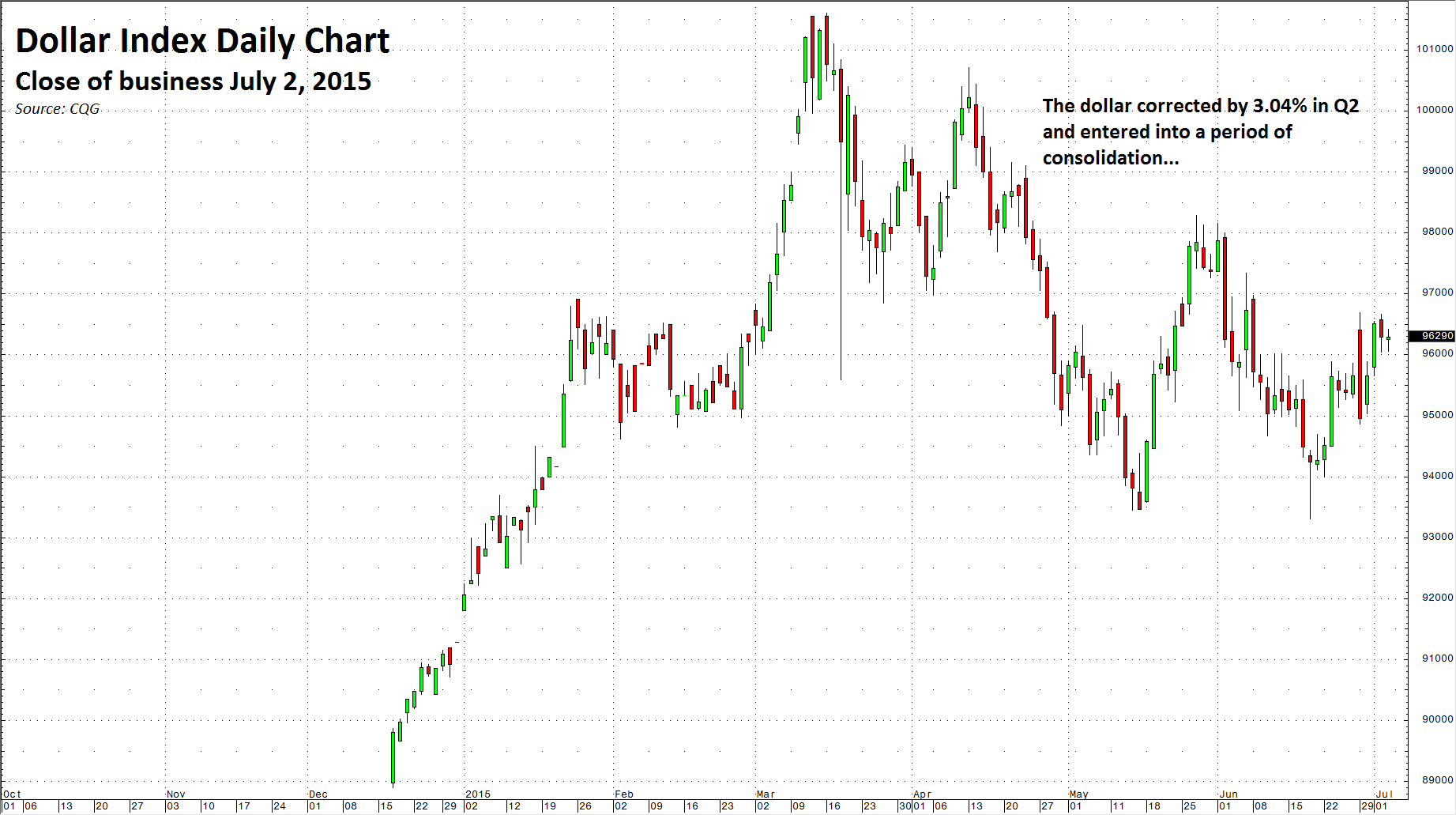The rally in the US dollar that commenced in May 2014 saw a period of correction and consolidation during the second quarter of 2015. The world's reserve currency has an inverse relationship with commodity prices. In this piece, I describe how commodity markets mirrored action in the dollar during Q2, point out winners and losers in these markets, and explain how action in the dollar and raw material values could give the US Federal Reserve the justification for a short-term interest rate rise before the end of 2015.
The Dollar and Commodities - Inflation?
The dollar index futures contract corrected 3.04% lower during the second quarter of 2015.
The dollar index closed Q2 5.53% higher for the first six months of 2015. The inverse correlation between the dollar and commodity prices held during Q2 with the dollar down 3.04% and a composite of 33 commodity prices up 3.15%. The correlation was almost perfect on a macro basis. In the first six months of 2015, the dollar index has moved 5.53% higher while the commodity price composite has moved only 3.72% lower. This tells us that commodity prices in 2015 have outperformed the dollar, which indicates a pickup in inflation. The Federal Reserve, in past months, has stated that they are waiting for a pickup in inflation before they hike short-term interest rates. This divergence between the dollar and commodity prices could provide some degree of justification for the Fed to raise rates before the end of 2015.
Metals Buck the Trend
While commodity prices overall moved higher in Q2, the only sectors where prices declined was the metal market. In fact, not one metal increased in value during the period from April through the end of June. Precious metals, as a sector, fell by 5.3% with palladium posting the largest losses down 8.52%. Silver lost 6.4% while platinum fell by 5.59%. Gold was the biggest winner in the precious metals sector, losing 0.96% of value during the second quarter. Meanwhile, base or nonferrous metal price slid lower during the quarter. The sector lost an average of 6.73%. Tin was the biggest loser, shedding 16.7% of its value in Q2. Nickel lost 6.56% while aluminum fell by 5.67%. Copper on the LME dropped by 4.77%. On COMEX the red metal declined 4.56%. Zinc was down 4.38% followed by the best performing base metal, lead, which lost 2.33% of its value.
A lower dollar and lower metal prices is a divergence from historical norms. However, a weak global economic landscape and continued pressure on the Chinese economy is the most likely reason for the weakness in metal prices in Q2.
All Other Sectors Move Higher
While metals moved lower, every other commodity sector posted gains. The best performing sector in Q2 was energy, which soared by 13.81%. The biggest winner in energy was NYMEX crude oil, which posted gains of 24.94%. Brent crude and gasoline were both up more than 15% and heating oil was up 10.65%. Natural gas added 7.27% while ethanol rallied by 8.8%.
Coming in second place was grains, which appreciated by 8.33%. Wheat was the big winner, up by 20.32%. Corn added 14.68% while soybeans moved 6.58% higher. The soybean crush rallied as soybean oil rallied by over 12% and meal was up 5.7%. Oats and rice posted small losses, down 0.28% and 3.86% respectively.
Soft commodity prices gained 5.52%, led by cocoa, which soared 21.12% in the second quarter. Supply worries over West African output added to bullish sentiment caused by a continuation of rising demand for chocolate confectionery products in Asia. Cotton gained 7.62% and sugar was up 4.52%. Coffee was little changed, falling 0.38%, but frozen concentrated orange juice fell 5.38% on weak demand.
Animal protein prices were mixed, with live cattle falling 8.21% and feeder cattle dipping by just 1% in Q2. Lean hog prices moved 18.95% higher over the quarter as a composite of the sector gained 3.24%.
Q3 - Volatility Ahead
There are some important takeaways from the action in commodity futures markets in the quarter that ended on June 30, 2015. Perhaps most important is the fact that commodity prices are outperforming the dollar so far in 2015. The prospects for an interest rate rise, based on an uptick in commodity price inflation, could be bad news for commodity prices in coming months. Higher US interest rates will support the dollar. This alone is likely to depress commodity prices; however, higher costs of financing commodity inventory may also lead to lower prices for raw materials.
Another factor that could bring some real volatility to commodity prices over Q3 and beyond is the strong El Niño that has developed. Warm waters in the Pacific Ocean have traditionally caused weather extremes around the world. Droughts, floods, excessive heat, frigid winters, hurricanes, and typhoons are often associated with El Niño. These types of weather events can wreak havoc with agricultural output; therefore, grains and soft commodities could be in for a wild ride.
Expect volatility to pick up across the board as potential interest rate hikes, El Niño, and a global environment of economic and political turbulence continues to influence commodity prices.
